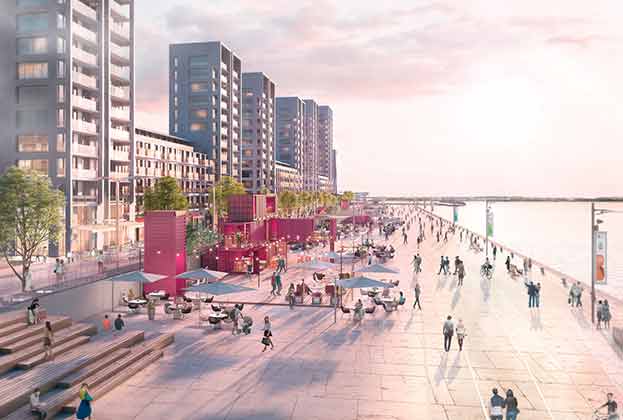Newham and Tower Hamlets are leading the way
There are over 350 development sites that we expect to be marketing private homes over the next five years, estimated to account for 31% of supply coming forwards across the whole of London. However, 20% of that is concentrated in Newham and Tower Hamlets alone, with just 5% in Havering, Redbridge and Waltham Forest combined.
Development potential in these three boroughs is constrained by the Green Belt, and despite the Planning Inspectorate’s recommendation that Sadiq Khan should lead a strategic and comprehensive review of the Green Belt in London, the Mayor rejected this possibility as part of the next London Plan review.
There is over 9,000ha of Green Belt land in the Eastern Corridor, and releasing land close to stations or where it is poor quality could provide opportunities for development to satisfy the increasing need for housing in London. Alternative options could include repurposing retail space or redundant offices, particularly in areas with a lack of quality town centre stock. For this to be a viable option, there will need to be developer engagement with the planning authority along with landowners recognising when existing uses no longer suit the specific location. Abbey Retail Park in Barking and Dagenham (full permission), and Ilford Retail Park (application) could provide over 2,000 homes between them.
Close proximity to stations and transport hubs will always be a priority, with clear pockets of development picking up around areas seeing infrastructure investment. The Barking Riverside rail extension, new Silvertown Tunnel and upgrades to Lee Valley rail service are expected to be functioning by 2025.
Ilford
A number of town centre developments are coming forward, most notably the 680 homes to be built above Sainsbury’s. More recently, plans have been announced to redevelop Ilford retail park into 2.5 acres of homes, offices and retail space to be branded as Ilford Eastside.
Romford
When Crossrail is operational, travel times from Romford town centre to key employment hubs will be cut by more than 20%, making it a more attractive option for central London commuters. Development of the former Ice Rink has gained permission for over 600 homes and 830 sq m of commercial floorspace, whilst a joint venture between First Base and Havering is to deliver a mixed-use development in the town centre including 1,000 residential units.
Barking Riverside and town centre
Aside from the 10,800 homes and new train station opening in December 2021, Barking Riverside will create a new riverfront town with schools and 65,000 sq m of commercial and cultural space. In Barking town centre, Gascoigne Estate and Abbey Quay have planning permission for over 2,500 homes combined.
Rainham
Beam Park spearheads development in Rainham, which will provide 3,000 homes to complement a new railway station, medical centre, two new schools and retail space. More recently, Clarion’s 717 home development has been granted planning permission.
More than just residential?
Whilst in the four highlighted areas there is significant amounts of residential development, the commercial and office markets have seen a distinct lack of activity. Romford & Ilford is a small office market that caters for small local occupiers but it is a strategic location that is set to benefit from infrastructure improvements. A lack of supply has resulted in take-up volumes being muted as there has been a lack of floorspace available over 10,000 sq ft. Permitted development rights have eroded the office stock levels in both markets, it estimated that at least 300,000 sq ft has been converted to residential.
The lack of supply in the market has resulted in rental growth. Headline rents in Romford have reached £20 per sq ft, increasing since 2016 where they were only £14.50 per sq ft. Further rental growth could be captured if refurbished stock was brought to the market. Romford has further room for rental growth and offers a discount to neighbouring markets such as Stratford and Brentwood.
Summary
The pipeline of the Eastern Corridor’s residential supply is largely concentrated around existing transport hubs Canary Wharf and Stratford, but with areas further east soon becoming more connected to central London, that is likely to change. Potential buyers are likely to have previously rented in more central parts of London, and to move further out will demand a similar standard of living. Successful placemaking is going to be vital to attract this demand. Whilst the office market in these areas has been muted so far, areas such as Romford still offers relative value compared to neighbouring markets and could well see rental growth in the future.
Read the other articles within London Development: Eastern Corridor below
.jpg)
